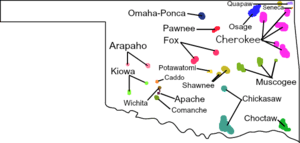Osage language facts for kids
Quick facts for kids Osage |
|
|---|---|
| 𐓏𐒰𐓓𐒰𐓓𐒷 𐒻𐒷, Wažáže ie | |
| Native to | United States |
| Region | Oklahoma |
| Ethnicity | Osage people |
| Extinct | 2005, with the death of Lucille Robedeaux |
| Language family |
Siouan
|
| Writing system | Latin (Osage alphabet), Osage script |
| Linguist List | qlc Kansa-Osage |

|
|

|
|
The Osage language (pronounced o-SAYJ) is a special language spoken by the Osage people. They live in Oklahoma, a state in the United States. Osage is part of a larger group of languages called Siouan.
One cool thing about Osage is that it has its own unique writing system. This system was created in 2006. This makes Osage one of the few native languages in the U.S. with its very own alphabet! It can also be written using the familiar Latin script, which is what English uses.
Bringing the Osage Language Back
For a while, fewer and fewer people spoke Osage. By 2009, only about 15 to 20 older people still spoke it as a second language. This meant the language was in danger of disappearing.
But the Osage people are working hard to bring their language back! In 2003, they started the Osage Language Program. This program helps people learn Osage by providing helpful audio and video lessons online.
Working Together to Revive Languages
In 2012, a special event called the 2nd Annual Dhegiha Gathering took place. This gathering brought together speakers of Osage and other related languages like Kaw, Quapaw, Ponca, and Omaha. They met to share ideas and learn from each other about the best ways to bring their languages back to life.
Making Language a Priority
In early 2015, the Chief of the Osage Nation, Thompson Raul Standing Bear, made a big announcement. He said that teaching Osage through "language immersion" would be a top priority. Language immersion means learning a language by being completely surrounded by it, like how you learn your first language. This shows how important it is to the Osage people to keep their language alive for future generations.

